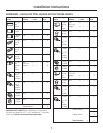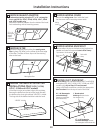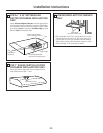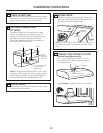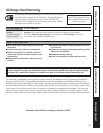
BEFORE YOU BEGIN
6
Installation Range Hood
Instructions
Read these instructions completely and carefully.
•
IMPORTANT – Save these instructions
for local inspector’s use.
•
IMPORTANT – Observe all governing
codes and ordinances.
•
Note to Installer – Be sure to leave these
instructions with the Consumer.
•
Note to Consumer – Keep these instructions
for future reference.
• Skill level – Installation of this appliance requires
basic mechanical and electrical skills.
• Completion time – 30 minutes–3 hours
• Proper installation is the responsibility of the installer.
• Product failure due to improper installation is not
covered under the Warranty.
NOTE: Read the ductwork sections only if you do not
have existing ductwork. If you have existing ductwork,
skip to the “Damage” section and proceed.
WARNING – TO REDUCE THE RISK OF FIRE AND
TO PROPERLY EXHAUST AIR, BE SURE TO DUCT AIR OUTSIDE—
DO NOT VENT EXHAUST AIR INTO SPACES WITHIN WALLS OR
CEILINGS OR INTO ATTICS, CRAWL SPACES OR GARAGES.
The venting system must exhaust to the outside.
This hood can be vented vertically through upper cabinets
or horizontally through an outside wall. Ductwork is not
included.
Exhaust connection:
The hood exhaust has been designed to mate with
standard 3
1
⁄4″ x 10″ rectangular ducting or 7″ diameter
round ducting.
If a 6″ round duct is required, a rectangular-to-round
transition adaptor must be used*. Do not use less than
a 6″ diameter duct.
Maximum duct length:
For satisfactory air movement, the total duct length
of a 3
1
⁄4″ x 10″ rectangular, 6″ or 7″ diameter round
duct should not exceed 65 equivalent feet. See the
WORKSHEET–CALCULATE TOTAL EQUIVALENT
DUCTWORK LENGTH section.
NOTE: It is important that ducting be installed using
the most direct route and with as few elbows as possible.
This ensures clear venting of exhaust and helps prevent
blockages. Also, make sure dampers swing freely and
nothing is blocking the ducts.
Elbows, transitions, wall and roofcaps, etc.,
present additional resistance to airflow and are equivalent
to a section of straight duct longer than their actual
physical size. When calculating the total duct length, add
the equivalent lengths of all transitions and adaptors plus
the length of all straight duct sections. The charts on the
following pages show you how to calculate total equivalent
ductwork length using the approximate feet of equivalent
length of some typical ducts.
* IMPORTANT: If a rectangular-to-round
transition adaptor is used, the bottom
corners of the damper will have to be
cut to fit, using the tin snips, in order
to allow free movement of the damper.
Equivalent lengths of duct pieces
are based on actual tests and reflect
requirements for good venting
performance with any hood.
DUCTWORK REQUIREMENTS
WARNING – Before beginning the
installation, switch power off at service panel and
lock the service disconnecting means to prevent power
from being switched on accidentally. When the service
disconnecting means cannot be locked, securely fasten
a prominent warning device, such as a tag, to the
service panel.
FOR YOUR SAFETY:
Questions? Call 800.GE.CARES (800.432.2737) or visit our Website at: GEAppliances.com
An optional Power Cord Connection Kit, model JXHC1,
is available at extra cost from your GE supplier for
installation using a standard 3-prong, grounded wall
outlet. Follow the Installation Instructions packed with
the kit to connect the power cord to the range hood.
OPTIONAL POWER CORD KIT JXHC1









